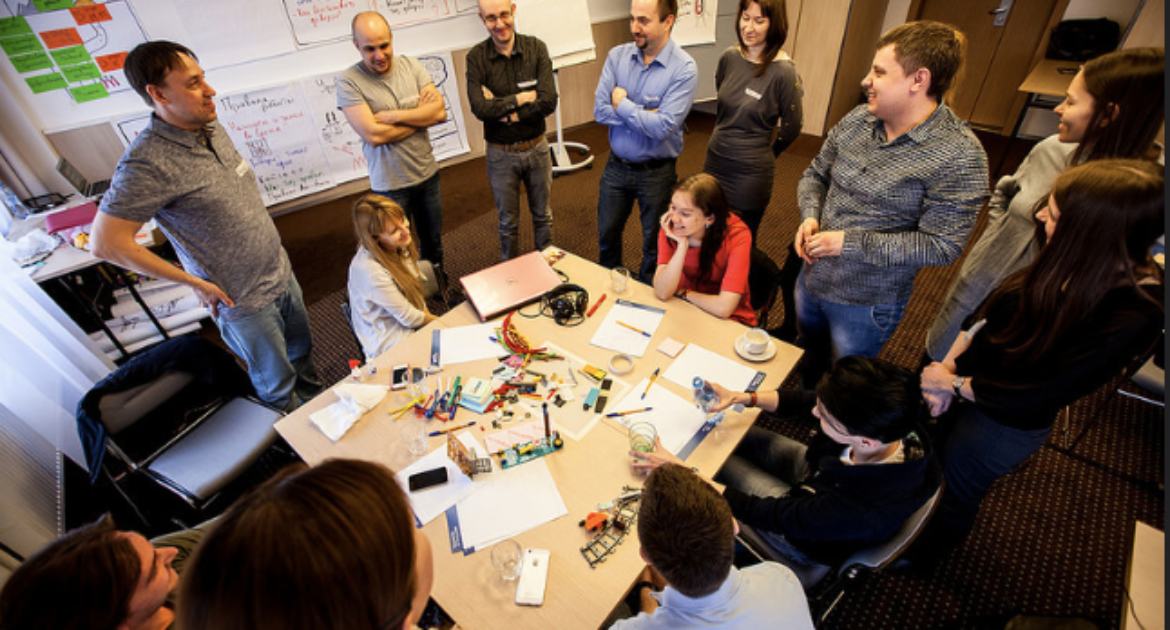5 Steps to CLEAR Agile Goal Setting

After determining a company’s quarterly business goals, then the products and services that will support them, executives and managers often don’t take the next step of collaborating with the folks on the ground before considering the goals complete.
The Last Resort
At many companies, executives hold quarterly offsites at posh resorts where the ‘strategery’ happens. Chicken dinners are served, stretch goals are written, and PowerPoint decks with pyramid graphics are created.
Soon after, mid-level executives fill the roadmap with products and services they think will achieve the goals (and pay for the chicken dinners).
Unfortunately, most quarterly planning processes stop when the executives leave the offsite, never having involved the folks on the front line who most need to understand rationale behind it.
Making the goals CLEAR
More and more executives, however, are adding a third step to the planning process, extending the planning process into collaborative workshops with development teams to make the company goals ‘CLEAR.’
CLEAR goals, created by Olympic medalist and entrepreneur Adam Kreek, are a flexible goal setting approach that involves the folks delivering the solutions.
CLEAR is an acronym for Collaborative, Limited, Emotional, Appreciable, and Refinable.
Compared to the more well-known SMART goal setting approach, CLEAR goals are flexible, team-based, and better aligned with a fast-changing business environment and Agile delivery.
In the world of Agile software development, the CLEAR goal-setting process is brought into multi-day workshops (often called “Inception Workshops”) for strategic initiatives, setting the projects off in the right direction as quickly as possible.
At a high level, the process works like this:
1. Collaborative
Executives, managers, and development teams put aside titles for a day or two to meet in a room to discuss the quarterly goals, the rationale behind the goals, the proposed product roadmap, and how the roadmap relates to the goals.
Then, in breakouts and whiteboard discussions, leadership and development teams work together to discuss how to take those goals the next step within the project.
In this setting, executives tend to learn as much as they teach. Their explanations of the thought process behind the goals opens the discussion to shortcuts, tools, and processes they may never have thought of.
2. Limited in Scope
In the workshop, executives and managers work together with the development team to map out the key user touch points (using user story mapping, user journeys, or use cases) noting where new products or services will be focused.
Next, using high-level estimation techniques, the development team estimates and discusses with executives what limited slices of functionality are likely to be delivered in the next 6 to 8 weeks.
3. Emotional
This step brings in the emotional story behind the planning process. Executives talk about the ‘why’ of the company and how this particular project relates to it.
With customer stories, videos, value statements (“1,000 songs in your pocket”), or vision statements (“Organize the world’s information and make it universally accessible and useful”), leadership tells the story of how achieving the overall product goals will affect the user and the world. The product vision describes the big picture of the customers the company is working to serve.
(Note: If I had my druthers, the ‘Emotional’ step would come first in the CLEAR process, but I guess ‘ECLAR’ doesn’t have the same ring to it.)
4. Appreciable
Appreciable goals are goals that will be appreciated by the company, the customer, and the team as valuable and instructive for future releases. Everyone needs to agree when a slight increase in use or conversion become significant. When does a drop in call wait time become significant? Executives and managers need to help development teams understand what matters and what it could mean when achieved (or not).
5. Refinable
Though the quarterly planning goals are core to the company’s success, as new information arises, executives have to give teams permission to recommend modifications.
Refinable means working together to define the tradeoffs that will need to be made as features and services are released. Is staying within budget more important than hitting the release date? Is reducing call center traffic more important than increasing conversions?
With the executives in the room, the teams discuss how to balance those choices.
Summary
The CLEAR goal setting process brings the quarterly planning into project kickoffs. In a show of collaboration and trust, it brings executives and managers into conversation with the development teams.
The result is a clearer understanding of the intent of the goals, mutual curiosity on how achieve them, and the beginning of an ongoing dialogue (Note: the workshop is the first in a cadence of conversations that will need to happen as the project progresses. More to come on this in future posts).
How are your executives and managers working to clarify your company goals?
Related Posts
-
ost of us go to SXSW for the music, the parties, and the bri...Mar 30, 2015 / 0 comments
-
The Viennese philosopher Karl Popper (1902-1994) is remember...Aug 02, 2013 / 0 comments
-
My dad was a politician, first an Ohio State Representative ...Nov 27, 2018 / 0 comments
Categories
Recent Posts
CONTACT INFO
Welcome to Coral Mountain Consulting, a Deliverse company. We are glad you found us. If you need to contact us, please call or email Barc directly.
Phone: 1-(626) 644-3857
Office: 2122 New York Drive, Altadena, CA 91001






